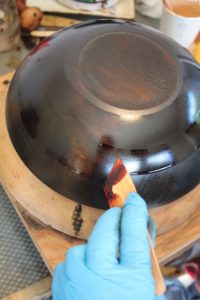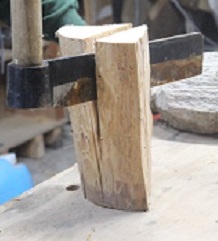I read a while back in a old book written by a master Japanese craftsman that lacquering truly becomes fun once a person becomes adept at using the wooden spatulas. In lacquer work they are used for a variety of tasks such as mixing pigments into the lacquer, cleaning the brushes and transfering lacquer from one place to another. Also, they are typically used to transfer lacquer to the work piece during brush finishes because they tend to attract less dust than brushes.
I recently turned a corner in my ability to make and use these spatulas, and they have truly revolutionized the way I plan to approach lacquering. I took me a while to make and learn to properly use a spatula on the curved surfaces of a bowl, but after learning to skew is as I rotate the bowl, it is possible to draw a thin layer all the way from the bottom to the rim cleaner, faster and using less lacquer than before.


The bowls sit on a defective bowl that is placed on a lazy susan, so I can rotate the base by hand as I draw the lacquer towards the rim. I then wipe off the excess and place it on the rack to dry.
I highly recommend these little spatulas to anyone. I can see them being used for other finishes or even glue. They are so easy to make, infinitely customizable and very eco-frienly.
I use hinoki cypress for mine, but almost any wood will work. Since the wood must be thin enough to bend yet not break, I split the blanks out of a piece of firewood I had in the pile. After splitting out a 6mm think piece, I flatten one side. This gives me a good feel for how the wood will work and creates a reference service to work towards. I then flip it over and taper it down to almost the final thickness.



At this point, despite the end being less than 1mm thick, the spatula is still quite stiff. The final shaping a all done with a push knife. After reducing the thickness towards the end, I cut the skew angle and the finish it off the the final thickness. At this point, minor changes can make a huge difference both is how and where the spatula bends. This is where practice and experience becomes important. Keep in mind, too, that the wood will loosen up a bit after repeated bending while in use, so it is better to aim for a slightly stiffer bend right now.
Lastly, I cut off the waste and soften the edges, and the spatula is ready to use. With a little practice, they only take about 10-15 minutes to make at most, and are well worth the effort. I look forward to finding out what other uses these little workhorses are suited to.


